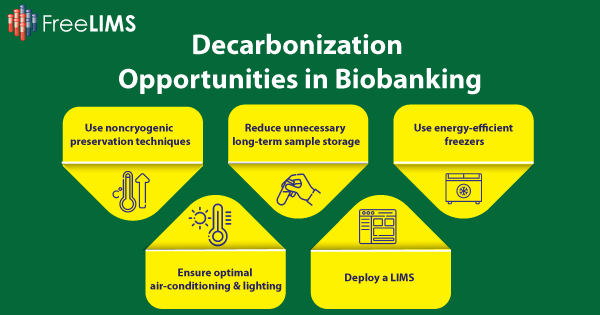Biobanks present an incredible opportunity for researchers, sparing them the arduous task of collecting, storing, and handling samples and data. By aggregating vast datasets, aptly referred to as “big data,” researchers can delve into crucial inquiries concerning public health, both within their communities and across the globe. However, despite their status as a valuable resource accessible to numerous researchers and often funded by the public, there has been a lack of sufficient focus on comprehending their environmental impact. The prevailing discourse falls short in acknowledging the significant environmental ramifications biobanks entail. This oversight is indeed concerning since biobanks leave a discernible carbon footprint that cannot be overlooked when contemplating their governance.
Decarbonization in Biobanking – Concerns and Challenges
The environmental consequences of biobanks originate from the way biosamples are stored and managed, primarily due to the energy-intensive operation of ultra-low temperature freezers. These freezers necessitate specialized temperature-controlled environments and require periodic replacement, thereby amplifying their ecological footprint. It is essential to recognize that these aspects significantly contribute to the environmental impact of biobanks.
Liquid nitrogen (LN2) emerges as a popular choice for preserving precious biological materials over the long haul. Its ability to create an ultra-low temperature environment adds an element of stability that researchers greatly appreciate. Yet, a perplexing gap exists in comprehending the details surrounding the costs and consumption of LN2, as well as the electricity usage entwined throughout the entire lifespan of an ultra-low temperature freezer. This knowledge void prevents us from grasping the true magnitude of the environmental impact and operational expenses associated with these freezers.
When we compare the biobanking landscape between high-income countries (HICs) and their low-and middle-income counterparts (LMICs), a glaring disparity becomes evident. LMICs not only have fewer biobanks per country, but their facilities also lack the necessary resources to effectively curb energy consumption and shrink their carbon footprint. Decarbonization, an essential topic on the global agenda, sadly remains on the back burner in LMICs, primarily due to the formidable financial investments that such transformative measures entail. For LMIC biobanks, striving for decarbonization solely through the acquisition of top-of-the-line deep freezers presents a financial hurdle that is not easy to overcome, even if they comprehend the urgency of decarbonization.
Approaches to Decarbonize Biobanks in LMICs and HICs
HICs possess the necessary financial resources to embrace and integrate energy-efficient technologies. It is imperative to thoroughly examine and assess these technologies within the current infrastructure and networks of biobanks, and aim to eventually broaden their adoption.
LMIC biobanks, while facing financial limitations, should not let this hinder their pursuit of decarbonization. Instead, they can focus on innovative approaches within their existing facilities and proactively maintain their equipment. By implementing behavioral and operational changes, they can make meaningful progress. One effective strategy is adopting a just-in-time model, which involves minimizing the storage of long-term samples to optimize limited space. LMIC biobanks have an opportunity to drive operational change by partnering with operating theaters to directly obtain tissues, thereby reducing the need for extensive processing and transportation. This collaborative approach minimizes resource requirements and streamlines the overall workflow. Moreover, LMIC biobanks can implement additional measures to enhance their sustainability efforts. For instance, they can adopt energy-efficient office lighting, optimize heating and air conditioning systems to conserve energy, and foster a paperless culture within the biobank to reduce waste and environmental impact. These small yet impactful steps align with the principles of efficiency and environmental responsibility, allowing LMIC biobanks to make a positive contribution within their means.
Enhancing Environmental Sustainability with Biospecimen Management Software
By implementing a biospecimen management software, biobanks can revolutionize their practices and reap a host of benefits. One such advantage is the transition from traditional paper-based records to a digital documentation system. This shift away from paper reliance not only reduces the carbon footprint associated with paper production, transportation, and disposal but also enhances the overall sustainability of biobanking operations.
A biobanking LIMS mirrors the storage structure of biobanks, providing biobank personnel with a convenient means to locate samples quickly, eliminating the need to open multiple freezers and navigate through racks and shelves. This streamlined functionality not only reduces temperature losses within the freezers but also minimizes the risk of compromising the quality of stored samples. By integrating with Temperature Monitoring Systems, biobanks can further enhance their operations by ensuring optimal temperature maintenance. These integrated systems play a crucial role in reducing unnecessary electricity consumption, thereby effectively minimizing the carbon footprint associated with biobanking activities.
Conclusion
The importance of decarbonization in biobanking is becoming increasingly significant as global energy costs rise. Embracing technological advancements, raising awareness of the current circumstances, and fostering behavioral changes are key components in shaping a brighter future for biobanking, even though the specific strategies may differ between high-income countries (HICs) and low-and-middle-income countries (LMICs). The integration of a biospecimen management software plays a pivotal role in reducing the environmental impact of biobanks by digitizing biobanking processes. Through focused discussions on this topic, the industry can generate informed and actionable recommendations that cater to the specific needs of biobanks in the near future. This collective effort paves the way for a more sustainable and efficient biobanking landscape.


